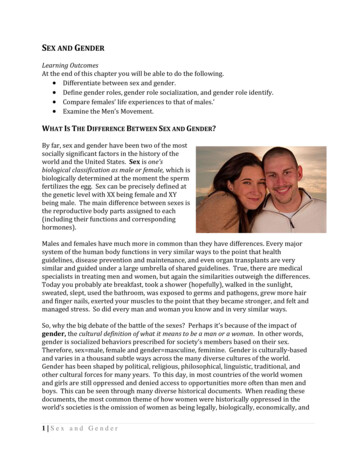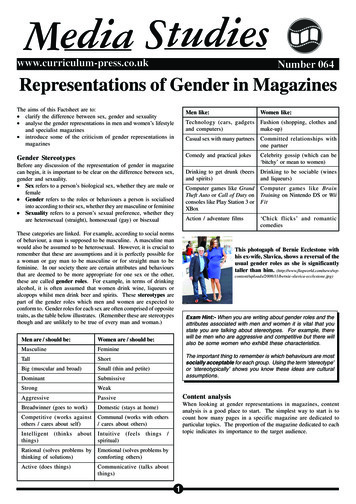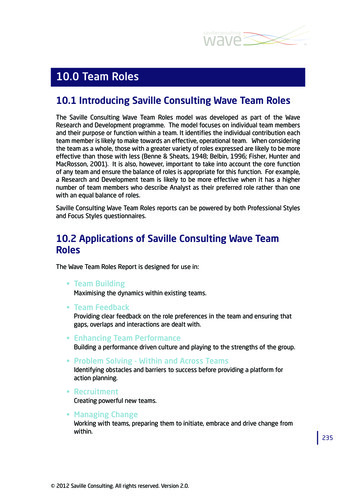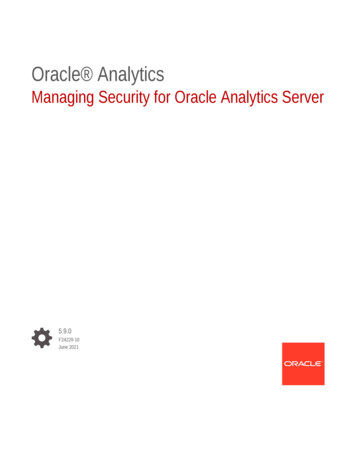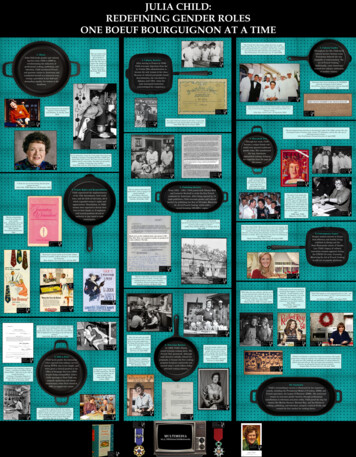
Transcription
JULIA CHILD:REDEFINING GENDER ROLESONE BOEUF BOURGUIGNON AT A TIME“The French don't like anyone telling them how to make*their* food. Plus, she was a cookbook author and a TV cook,not a professional chef in a restaurant. And she was a woman,not a man, French chefs back then were mostly male.- Alex Prud’homme, Personal Interview, 21 April 2020“The one notion of theFrench kitchen shehad no desire toreplicate was the sexof the chef. She saw noreason why women aswell as men should notpursue that career.”- Nancy Verde Barr,Backstage With Julia,20071. ThesisJulia Child broke gender and culturalbarriers from 1950 to 2000 byrevolutionizing the industries ofprofessional cooking, publishing, andtelevision. Child introduced Frenchand gourmet cuisine to Americans andestablished herself as a historical icon,setting a precedent in her field anddemanding equality for women in theworkforce.4. Culinary BarriersAfter moving to France in 1948,Child overcame objections from theLe Cordon Bleu administration tobecome the only woman in her class.Because of cultural and gender-baseddiscrimination, she was denied adiploma until 1951, when themale-dominated institutionacknowledged her competence.7. Cultural ConflictThroughout her life, Child facedcultural barriers because someFrenchmen believed she wasincapable of understanding “theart of French Cooking.”Additionally, some Americansresisted her culinary celebrationof another country.Child At Le Cordon Bleuwith mentor Max Bugnard1949Harvard Schlesinger LibraryRadcliffe Institute“Americans don’t know anything at all, NOTHINGabout the techniques of good cooking.”- Avis DeVoto, Harvard Schlesinger Library, RadcliffeInstitute, 12 January 1958Chef Gilles Epié(center) with team ofL'Orangerie1995,Gayote“She was featured as the symbol ofAmerica’s ‘food revolution.”- Joan Reardon, As Always, Julia,2010“Americans have really slammed French cuisine.they think weonly eat boeuf bourguignon [like Julia Child] and rabbit stew,which is wrong.”- Gilles Epie, Seattle Times, 18 September 2009Diploma fromLe Cordon Bleu15 March 1951Smithsonian InstituteThe French ChefChild’s Omelette,27 February 1972Harvard SchlesingerLibrary, RadcliffeInstitutemight well prove formidable to the American housewife.Huffington MifflinRejection letter1959Harvard SchlesingerLibraryRadcliffe Institute“As a girl, I had zero interest in the stove.I was neverencouraged to cook and just didn't see the point in it.”- Julia Child, My Life In France, 2006Julia Cooking in HerParis Kitchen1950Harvard SchlesingerLibraryRadcliffe Institute“She also helped develop television as the dominant media of the 1960’s and the 70s, andencouraged women to become cooks, writers, TV performers, and the like. She was aninfluential mentor to many."- Alex Prud’homme, Personal Interview, 21 April 20208. Household IconThrough her work, Childbecame a unique female rolemodel who ignored traditionalgender roles. She transformedthe way Americansapproached cooking, bringingher expertise from the page tothe screen.Julia Child Portrait1978Lynn Gilbert“In my generation, except for a few people who'd gone intobanking or nursing or something like that, middle-classwomen didn't have careers. You were to marry and havechildren and be a nice mother. You didn't go out and doanything. I found that I got restless”- Julia Child, Interview With Polly Frost, 16 July 2009Portrait of Julia Child1971BIOGRAPHY “Over the rank of secretary, there is no woman in the organization [ofKnopf Publishing House].so I hope to make myself [Avis DeVoto]indispensable. “Letter from editor andfriend Avis DeVotoSeptember 1956Harvard SchlesingerLibraryRadcliffe InstituteLes Trois Gourmandes:Julia, Simca, Louisette1953Harvard SchlesingerLibrary Radcliffe Institute“I think one can see from history that the greatcreators are men.”- Julia Child, TIME Magazine, 26 November 19662. Female Rights and ResponsibilitiesChild experienced the implementationof the 19th Amendment, both worldwars, and the birth of television, all ofwhich expanded women’s rights andopportunities. Nonetheless, in 1950,women were expected to devote theirlives to their family or, if employed,hold menial positions devoid ofauthority or pay equal to malecounterparts.“Become a fascinatingwoman by putting yourman’s needsfirst.essentially, this is allabout shutting up andletting the man be a man.”- Helen Andelin,Fascinating Womanhood,1963Julia Child singingWith other chefsJuly 28 1992Getty Images“I fell in love with thepublic, the public fell inlove with me, and I try tokeep it that way.”- Julia Child, New YorkTimes Interview, 20035. Publishing BarriersFrom 1951 - 1961, Child joined chefs Simone Beckand Louisette Berthold to write the first Frenchcookbook for Americans. After being rejected by 21male publishers, Child overcame gender and culturalbarriers by publishing her first of 18 books, Masteringthe Art of French Cooking, which sold arecord-breaking 100,000 copies.“You are going to beat them allhands down.yours is going to bea great cookbook.”- Avis DeVoto, HarvardSchlesinger Library, RadcliffeInstitute, 23 October 1953Child, One Of FourWomen On A 1966TIME Magazine Cover,November 25 1966“No matter if she breaks therules.Her viewers on 104educational TV stations acrossthe US.adore her. Manhattanmatrons refuse to dine out thenight she is on.Julia Child's TVcooking shows have made her acult from coast to coast and puther on a first-name basis with herfans.”- TIME Staff, TIMEMagazine, 25 Nov 1966Celebration After ChildIs Awarded FrenchLegion D’Honneur2000Getty Images“.the enthusiasts around here are absolutelyconvinced that this book is revolutionary and we intendto prove it and to make it a classic.”- Judith Jones [Child’s Editor], As Always Julia, 6May 1960------Black news on the cookbook front.the answer is NO,Neg, Non, Nein.too expensive to print, no prospects ofa mass audience. Too bad.Don’t Buy Julia Child’s Mastering the Art of French Cooking. Youwill never cook from it.the inconvenient truth is that although thecountry’s best-loved “French chef” produced a.recipecollection.it has always been daunting. It was never meant for thefrivolous or trendy. And it now seems even more overwhelming ina[n efficient] world.”- Regina Schrambling, Slate Group, 28 August 2009Child Signs Fans’BooksJanuary, 1977Shutterstock9. Contemporary LegacyDespite modern interest in frozenfood efficiency and healthy livingexhibited in dieting and theSemi-Homemade culture of SandraLee, Child’s legacy of culinaryinnovation remains apparent duringthe COVID-19 crisis. Currently,Mastering the Art of French Cookingis sold out on popular platforms.Fascinating WomanhoodBook Cover1974Helen Andelin“Each time a woman stands up for herself, withoutknowing it possibly, without claiming it, she stands upfor all women."- Maya Angelou, New York Times, 23 July 2007No Neit Nian LetterNovember 1959Harvard SchlesingerLibraryRadcliffe InstituteSandra Lee Holdinga Semi-Homemade DishFebruary 10 2010Getty Images“Honest to God Julia, you have brought arevolution into this household. I wholly expect thecompleted book to cause a real revolution.”- Avis DeVoto, Harvard Schlesinger Library,Radcliffe Institute, 20 March 1953Avis DeVoto and JuliaChild Sitting Outdoors18 May 1956Harvard Schlesinger LibraryRadcliffe Institute“Well Julia, she was a pioneer, and she set outto write the book that would tell us how tocook French food.the recipes.who the heckwould have the patience.but, I learned howto cook, really, from Julia Child.”- Martha Stewart, PBS, 15 August 2012United States Navy Recruiting1917Howard Chandler ChristyLibrary Of CongressVan Heusen TiesSexist Advertisement1951Smithsonian InstituteHardee’s AdvertisementLimits Women toHousehold Kitchen1940Smithsonian Institute“I was going to be a great woman novelist. Then thewar came along and I think it's hard for youngpeople today, don't you, to realize that when WorldWar II happened we were dying to go and help ourcountry.”- Julia Child, My Life in France, 2006Filming The French Chef1965Harvard SchlesingerLibraryRadcliffe InstituteChild at Kandy, Ceylon1944Harvard SchlesingerLibraryRadcliffe InstituteChild’s SignedOath Of Office16 November 1942OSS Personnel Files“[S]omeone with a bachelor’s degree inhistory [would go to] Officer CadetSchool (OCS). then start at the rank ofsecond lieutenant.”- Professor Christopher Hamner ofGeorge Mason University, PersonalInterview, 18 November 2019Paul Photographingfor Mastering the Artof French Cooking1975Getty Images3. OSS to ParisChild faced gender discriminationwhen rejected from military serviceduring WWII, due to her height, andwhen given a clerical position in theOffice of Strategic Services (OSS)despite being overqualified. Julia’s1945 marriage to Paul Child wasuniquely egalitarian and almostrevolutionary when Paul retired in1961 to support her career.“I was lucky to marry Paul. He was a greatinspiration, his enthusiasm about wine and foodhelped to shape my tastes, and his encouragementsaw me through discouraging moments. I wouldnever have had my career without Paul Child.”- Julia Child, My Life In France, 2006“Also, the men who ran publictelevision back then didn't alwayslisten to her good suggestions -for things like hosting a cookingshow with other chefs as herguests.”- Alex Prud’homme, PersonalInterview, 21 April 2020“We don’t review cookbooks.”- Alfred Duhamel (rejecting herappearance on his show, I’veBeen Reading), 1970“I was never a spy. I was withthe OSS organization. We hada number of women, but wewere all office help.”- Julia Child, My Life inFrance, 2006Julia and Paul ChildHaving Tea1968Rick FriedmanLibrary of Congress6. Television BarriersIn 1963, Child’s Emmyaward-winning cooking show, TheFrench Chef, premiered. Althoughmale directors initially refused herproposals, it became the first cookingprogram broadcast nationwide andstarted today’s multi-billion-dollartelevised cooking industry.Rachael Ray BookCover2019Penguin RandomHouseJulia Child and MarthaMake aCroquemboucheDecember 6 1995CBS“And then people called in, andWGBH was not used to havingpeople call into one of thoseshows, saying “that was great!Get more of that tall woman withthe whisk!”- Nancy Verde Barr, PersonalInterview, 9 April 2020Julia with Chefs andStudents at the FrenchCulinary InstituteCirca. 2000Backstage with JuliaIna Garten cooking inHer kitchenDecember 2019NBC Newswire“[Child’s] contribution to American cuisine was immense. She taughtpeople home cooking by making it fun, sophisticated and trendsetting atthe same time. Her cookbooks and philosophy of cooking influencedmillions then and still now. She was unique and exceptional. I learnedfrom her, we all learned from her and she is missed.”- Jacques Pépin, Personal Interview, 22 April 202010. ConclusionChild’s extraordinary success is illustrated by her numerousawards, including the Presidential Medal of Freedom (2003) andFrench equivalent, the Legion D'Honneur (2000). She motivatedwomen to overcome gender barriers through professionalcontributions in television and print media. Child paved the way forwomen like Martha Stewart, Rachael Ray, and Ina Garten incooking, publishing, and television, merged a cultural divide, andcreated the first market for cooking shows.Emmy Nomination Letter25 April 1966Harvard SchlesingerLibraryRadcliffe InstituteJulia Child'sPresidential MedalOf Freedom23 July 2003Julia Child FoundationJulia Child’sLegion D’Honneur19 November 2000Julia Child Julia Child Stamp16 September 2014US Postal ServiceMastering The ArtOf French CookingFirst Edition CoverOctober 1961Knopf Publishing“Julia Child taught an entire generation how to cook – andshe had such fun doing it on TV! I will be forever in herdebt.”- Ina Garten, Smithsonian, 13 August 2012Child With A KnifeOn Television1963Harvard SchlesingerLibraryRadcliffe InstituteChild At Emmy Awards22 May 1966Harvard SchlesingerLibraryRadcliffe InstituteThe French ChefDVD Cover26 April 2005PBS"Child really was the forerunner foreverything that happens on the FoodNetwork. [I get] lumped in withSandra Lee, but whatever. I try to domore than that—and I think it'simportant, for example, to startrelearning to cut up whole chickens[like Child]."- Rachael Ray, Newsweek,7 August 2009
Julia Child:Redefining American Gender RolesOne Boeuf Bourguignon At a TimeNatalie Harris and Anna TurneyJunior DivisionExhibitProcess Paper: 500 wordsProject Word Count: 500
Our topic brainstorming was focused on heroic women of WWII because we were intrigued bythe sexism they overcame. However, no subject stood out until we read a New York Timesarticle titled "The Women Whose Secret Work Helped Win WWII." Julia Child was listed as anemployee of the Office of Strategic Services (OSS). Although Child did not have the spy-actionstory we were seeking, she was deeply affected by gender barriers throughout her life. Our initialimpression of Child as “just a silly chef” and Saturday Night Live skit was a barrier throughoutour project. We even questioned her relevance in “breaking barriers” when looking at projects onwar, tragedy, and life-changing discoveries at our affiliate contest. Throughout this process,we've learned that Child impacted millions of people in unique and powerful ways and should betaken seriously.At first, our research focused on secondary source websites, cookbook reviews, timelines fromthe Julia Child Foundation, and clips from The French Chef . When we started to build ourproject, the Harvard Schlesinger Library Julia Child Collection, composed of thousands ofpapers, letters, and photos, quickly proved to be an invaluable resource. We contacted the libraryand worked closely with the librarians and a former NHD student at Harvard to access thesematerials. We also contacted many of Child’s living friends and were able to interview herexecutive chef Nancy Verde Barr, her television partner Jaques Pepin, and her nephew andco-author, Alex Prud’homme. During our interview with the Executive Director at the AsiaTrade Center, Dr. Deborah Elms, we connected COVID-19 challenges to flexible businessmodels.After months of research, we each wrote extensive historical papers about Child and merged andcondensed our papers into captions. We were impressed by the example exhibits hanging in ourclassroom, which decided our category. Then came the exciting process of purchasing materials,selecting evidence, and printing and reprinting our captions. Although COVID-19disappointingly forced us to create a virtual exhibit for Nationals, we were still excited to attemptan improved project. We positively used the digital platform by, for example, creating apegboard background based on Child’s actual kitchen at the Smithsonian and adding The FrenchChef ’s symbol to our image tags.Child faced negative gender and cultural barriers throughout her life. Rejected by dozens ofpublishers, denied degrees, and ignored by television producers, she was forced to find a newapproach, similar to how everyone is coping with COVID-19. Child had a novel goal of bringingFrench cooking to Americans through new text features and a new platform: television cookingshows. She devoted her life to merging a cultural divide and establishing possibilities for femalerecognition as professionals in the kitchen and beyond. We appreciated that Child had a lifetimeof unique contributions past the culinary world, and we wanted our project to help othersunderstand that she was much more than a flamboyant woman on television. In line with Child’saccomplishments and extraordinary spirit, we’ve broken barriers in our project.
Julia Child:Redefining American Gender RolesOne Boeuf Bourguignon At a TimeNatalie Harris and Anna TurneyJunior DivisionExhibitAnnotated BibliographyProject Word Count: 500
Primary SourcesArtifactsBush, George W. Julia Child's Presidential Medal Of Freedom. 23 July 2003One of the areas of our project we wanted to focus on was establishing Child as a prominenthistorical figure. Child was much more than a flamboyant woman cooking on TV and was somuch more than a cook. Receiving a Presidential Medal Of Freedom, or a French equivalent, theLegion D'Honneur, shows her importance beyond the kitchen. Taking our analysis of her careerbeyond cooking was what brought her importance to the next level.Chef Julia Child Is Inducted as a Chevalier in the Ordre National De La Légion D'Honneur(Legion of Honor) by Chef and Knight in the French Legion of Honor, Roger Fessaguet (R)at a ceremony in Boston, Massachusetts. 19 Nov. ild-foundation-sues-airbnb-over-idUSKCN0Z82HNThis source was beneficial as to help us to understand the long term impact she had on society inFrance, what this prestigious award is, and what it means when someone receives it, especiallywhen they are technically not French. Knowing that she received this award helped us further ourresearch on her accomplishments and her legacy left behind.Child, Julia. Diploma from Le Cordon Bleu. 0AD, National Museum of American History,Washington, DC, rch/object/nmah 892279After moving to Paris, Child enrolled at the revered cooking school, Le Cordon Bleu, where shefaced both gender and cultural barriers. Initially, Child had to fight to be moved from a"housewife's course" to a more serious professional class. In this new class, like countless otherinstances during her future career, Child was the only woman in the room. In addition, Child, asan unpolished American, was disliked by some of the French and was not taken seriously norpopular among the French country. This diploma represents Child's triumph over a schooladministrator, Madame Elizabeth Brassart, who unjustly withheld the diploma for over a year,and the gender and cultural barriers represented within the institute.Joint Resolution of Congress proposing a constitutional amendment extending the right ofsuffrage to women, approved June 4, 1919.; Ratified Amendments, 1795-1992; GeneralRecords of the United States Government; Record Group 11; National ld came on the air just when the Nation needed her most when only a handful of women werebreaking through the glass ceiling of gender barriers. Just after Child's birth, the ratification ofthe 19th Amendment gave women the right to vote and made a significant advancement forwomen's rights. It made it less impossible for Child to have a successful career. However, Childwas still underestimated and continuously undermined simply because of her gender.Postal Service, US. Julia Child Forever USA Stamp.Another symbol of Child's success and importance was getting a postal stamp in her honor. Thisrecognition is traditionally presented to historical figures, influential politicians, and popularcultural icons that acknowledge Child as someone of importance in each of the categories. Wefound this source when looking through the Getty Images Julia Child catalog and immediately
recognized the importance of such an artifact.BooksAndelin, Helen B. Fascinating Womanhood . Santa Barbara, CA, 1974.When we first discovered this book, we were horrified about the extreme bias towards theperspective that it was a woman's utmost important job to support her husband to becomesuccessful and masculine. However, it allowed us to understand the social expectations andnorms for women throughout the majority of Child's lifetime, particularly in the 1950s and 60swhen she was working hard to develop a career. By understanding the barriers Child faced wewere able to gain a better understanding of how significant Child's career was at a time when,according to one of the few female authors existing, women were only rarely even "justified" tohave a career. In 2019 a sixth edition was released, which really astounded us as we could neverimagine believing the disgusting rhetoric from this collection of videos and writing. This bookreally made us think about how privileged we are to be living in a time and place that treats ussimilarly, if not the same, to our brothers.Bertholle, Luisette, Beck, Simone, Child, Julia, et al. Mastering the Art of French Cooking.Cassell, 1963.Child's entrance into the professional culinary world was marked with the creation of her firstcookbook. This masterpiece represented her triumph over both the gender barriers in thepublishing industry and the cultural barriers in creating a French cookbook for Americans,something nobody, male or female, had ever executed nor thought to do before.Child, Julia, and Prud'homme, Alex. My Life in France . Alfred A. Knopf, 2012.My Life in France is a book Child wrote after her husband, Paul, died. He had always referred towriting this book as the "France book," and Child thought it could be a tribute to her husband. Inthis book, Child shares her experiences in France and all of the moments when she felt she waschanging the world somehow. This is extremely helpful for us because it was a reliable primarysource of her life's work's beginnings. This was also the last book Julia co-wrote with hergrandnephew Alex Prud' homme and passed away while the book was in progress. We used thisbook a lot as inspiration for her thoughts and many quotes throughout our project.Documents“RG 226, Records of the Office of Strategic Services Entry 224: OSS Personnel Files Box #: 514 ia/oss/McWilliams Child Julia.pdfThese records are a 130-page collection of official government records of Julia McWilliams(later known by her married name: Julia Child) 's assignments and efforts during her work for theOffice of Strategic Services (OSS) during WWII. We found this treasure trove towards thebeginning of our research process, and it brought up many questions. We wondered about whyher initial assignment was "involuntary," we wondered how gender barriers impacted her successin the OSS, and if she enjoyed her career there. This was not just a very reliable primary sourcefull of useful information; it was also the first primary source about our topic that we had toanalyze and make sense of deeply.Email CorrespondencePepin, Jacques. 22 April 2020
Child's good friend and close co-worker for several decades, Jacques Pepin, was a dreaminterview for us. They spent years together filming their famous shows: J ulia and JacquesCooking at Home and Julia and Jacques: More Cooking in Kitchen . After bombarding Mr. Pepinand his agents with emails, Facebook messages, and Linkedin requests, the impossible happened:the celebrity chef worth over 20 million dollars got back to us. When we talked to Mr. Pepin, heshared some fantastic quotes on a broad range of topics from their work and friendship to how heperceived Child's personality to how she handled criticism.Prud’homme, Alex. April 21 2020When we had first started researching and were reading books, we became quite familiar withthe name Alex Prud' homme. He was the grand-nephew of Child and an award-winning author.Together they co-wrote three books. We had first tried to contact him back in December;however, he was extremely busy writing his new book, and he did not have time to conduct aninterview with us. We reached out to him one more time in April, and he responded with alengthy 14 paragraph email detailing many parts of her life that would be extremely critical inestablishing and building the cultural barrier in our project.Verde Barr, Nancy. 9 Feb. 2020.After reading Nancy Verde Barr's memoir about her work with Child as her executive chef from1980 to 1998, Backstage With Julia , we contacted Ms. Verde Barr with several questionsregarding the gender discrimination Child faced in the creation of her television show, TheFrench Chef. From an email correspondence, we not only gained further understanding of theimpact Child had on Ms.Verde Barr and the American public but also Child's personality later inlife.InterviewsBerman, Fern. “Star Chef Julia Child Interview.” Star Chefs, Accessed 25 Nov. ew.shtmlThis interview gave insight into how Child thought about her career. Child also told FernBerman that the proudest moment of her illustrative career was her work with French bread. Shesaid this because it was the thing that in the US, most people did not have any clue how to makeit. She also mentioned how she felt about certain modern appliances like the bread machine andthe food processor."Interview With Julia Child." The Library of Congress. N. p., 1991. Web. 28 Oct. 04chi01/2004chi01.pdfThis was helpful because someone who is no longer living and we do not have the opportunity tointerview them. Most of the questions that were asked would be something along the lines ofwhat we would want to ask Julia. This series of interviews was helpful as it clarified many thingsthroughout her life that were maybe wrongly portrayed by the media.Child, Julia. “Julia Child Interview with Polly Frost.” Aug. 1989, Accessed 2020.https://books.google.com.sg/books?id Qa9QDwAAQBAJ&pg PR4&lpg PR4&dq julia child interview with polly frost magazine&source bl&ots a8Yrxo60a4&sig ACfU3U2ryxOMTErcyOtnKaVgaoheKEI5dw&hl en&sa X&ved 2ahUKEwi48oj1wfXnAhWV6nMBHSBoBzsQ6AEwA3oECAoQAQ#v onepage&q polly%20frost&f falseIn this interview with Polly Frost, Child gives insight into the negative rhetoric and the way she
was being criticized and received negatively. This was critical because it helped us see the themeof breaking barriers in a new light and helped us shine a light on a different aspect of Child thatwe had not focused on as much before."Julia Child." Television Academy Interviews. N. p., 2017. Web. 17 Dec. rviews/julia-child?clip 82993#interview-clipsThis interview with Child went through all aspects of her life, adding up to three houses of Childtalking about her life and the struggles that she was entitled to being a celebrity chef, author, andtelevision host. She also talked about what she thought was her most significant impact on themodern world and the impact at the time.LettersMifflin, Houghton. “Rejection of ‘Mastering the Art of French Cooking’ Manuscript.” Receivedby Julia Child, 1959.This is a letter of rejection from publisher Houghton Mifflin regarding Child's first book,Mastering the Art of French Cooking, on the grounds of being "formidable to the Americanhousewife frighten [ing]" which was not the "short, simple book directed to thehousewife/chauffeur" he was looking for. This shows gender barriers via the status quo in the60s. Later, when her book was a bestseller and Julia became a historical icon, Houghton Mifflinstated that they regretted not accepting her and wished they had the opportunity to work with her.Newspaper ArticlesTIME staff. “Food: Everyone's in the Kitchen.” TIME, 25 Nov. e-kitchen/This primary source article was one of the first important main newspaper articles written aboutChild when she was still trying to grow her career. It is not only valuable evidence of how thegeneral public perceived Child in America during the 1960s, but also a significant measure of hersuccess. In fact, during 1966, only 4 out of the authors of the article included interesting quotesand evidence that we later were able to track down for our resources as well.PhotographsBiography.com. N. p., 2019. Web. 7 Oct. hildThis short overview of Child's life gave us good background knowledge about how she influenced manydifferent areas of culture and economy, including television, women's rights, literature, and cooking. Itshowed us how important she was to the United States beyond solely the worlds of French cooking orfilm and helped guide our thinking about why Child mattered. In addition, it provided us with anexclusive portrait of Child, which we felt captured her vibrant personality.“Julia Child Collection.” ShutterstockShutterstock had a vast collection of photos of Child and her work. We used these photos toillustrate how she became a role model and a historical figure in many different professionalfields.“Julia Child Photo Collection.” Getty Images,www.gettyimages.com/.This was a collection of high-quality images that we used when we could not find what we were
looking for were not housed by the three libraries with collections of Child. (Harvard SchlesingerLibrary, The Smithsonian, and The Julia Child Foundation). Although Getty Images has noconnection to Child herself, we were able to find many useful pieces of evidence through thiscollection."Julia Child Collection." Smithsonian Institution. N. p., 2020. Web. 8 Feb. 2020.This website was critical in finding photographs of Child's life because the Smithsonian housesall sorts of items from her entire kitchen in France to her Emmy award and photographs that Paultook. The Smithsonian gave us access to documents and photographs from her early life inFrance and the OSS to her later years in Pasadena, California."Julia Child." Radcliffe Institute for Advanced Study at Harvard University. N. p., 2012. Web. 16Dec. -library/collection/julia-childThis collection of photos and documents from the Schlesinger Library at Harvard Universityhelped us understand what was happening at the time and Child's life through a visual eye. Thesephotographs show us things from her daily schedule to pictures of her with Simone Beck andLouisette Bertholle. Child is also pictured with her husband Paul and scripts for her TV show.She is also pictured writing letters to school children inviting them to come and learn to cook.VideoChild, Julia, director. The French Chef. Television Show, 1963.Along with Julia Child, came some phenomenal real-life footage at our disposal. We were
Le Cordon Bleu administration to become the only woman in her class. Because of cultural and gender-based discrimination, she was denied a diploma until 1951, when the male-dominated institution acknowledged her competence. 5. Publishing Barriers From 1951 - 1961, Child joined chefs Si




